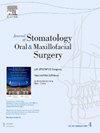正颌外科手术中基于三维断层扫描的软组织渲染系统与 Proface 面部扫描系统的对比分析。
IF 1.8
3区 医学
Q2 DENTISTRY, ORAL SURGERY & MEDICINE
Journal of Stomatology Oral and Maxillofacial Surgery
Pub Date : 2024-09-21
DOI:10.1016/j.jormas.2024.102088
引用次数: 0
摘要
目的:本研究旨在使用两种不同的三维成像方法,研究接受双颌正颚手术患者鼻唇软组织的线性和角度差异。此外,通过比较研究中使用的成像方法所获得的数据,确定了这些方法的优缺点和局限性:对 22 名接受上颌前突手术的患者的术前(T0)和术后 6 个月(T1)锥束计算机断层扫描(CBCT)和三维面部扫描(3DFS)数据进行了检查。使用 Dolphin 软件(Dolphin Imaging®, Version 12, Chatsworth, CA, USA)分析了患者的 DICOM(医学数字成像和通信)数据(CBCT 组)和".obj "格式图像(3DFS 组)。在确定两组患者的参考解剖地标后,计算软组织的线性和角度测量值:比较了 CBCT 和 3DFS 成像方法在 T0、T1 和所有测量(T0+T1)时的测量结果。在 T0 和 T0+T1 时进行的五次测量中,CBCT 组和 3DFS 组之间未观察到有统计学意义的差异,但在其他七次测量中,两组之间观察到有统计学意义的差异。CBCT 组和 3DFS 组在 T1 的六次测量中没有统计学意义上的显著差异,但在其他六次测量中各组之间存在统计学意义上的显著差异。对鼻唇沟软组织的术后差异进行复查后发现,3DFS 组的四个线性测量值和一个角度测量值的增加具有统计学意义,而 CBCT 组的两个线性测量值和两个角度测量值的增加具有统计学意义。在比较术后软组织改变的差异时,3DFS 组和 CBCT 组在任何软组织测量方面都没有观察到有统计学意义的差异:结论:正颌手术对鼻宽和上唇形态有显著影响。尽管 3DFS 和 CBCT 方法都可用于评估这些影响,但本研究的结果显示了这两种方法在灵敏度和局限性上的差异。因此,在评估手术效果时应考虑上述参数。本文章由计算机程序翻译,如有差异,请以英文原文为准。
Comparative analysis of 3D tomography based soft tissue rendering and Proface facial scanning systems in orthognathic surgery
Purpose
This study aimed to investigate the linear and angular differences in the nasolabial soft tissue in patients who underwent bimaxillary orthognathic surgery using two different three-dimensional imaging methods. Furthermore, the advantages, disadvantages, and limitations of these methods were determined after comparing the data obtained from the imaging methods used in the study.
Materials and Methods
Preoperative (T0) and 6-months postoperative (T1) cone-beam computed tomography (CBCT) and three-dimensional facial scanning (3DFS) data from 22 patients who underwent maxillary advancement surgery were examined. The DICOM (Digital Imaging and Communications in Medicine) data (CBCT group) and “.obj” format images (3DFS group) of the patients were analyzed using Dolphin software (Dolphin Imaging®, Version 12, Chatsworth, CA, USA). The linear and angular soft tissue measurements were calculated after determining the reference anatomical landmarks for both groups.
Results
Measurements with CBCT and 3DFS imaging methods were compared at T0, T1, and all measurements (T0+T1). No statistically significant difference was observed between the CBCT and 3DFS groups for five measurements performed at T0 and T0+T1, but statistically significant differences were observed between the groups for the other seven measurements. There was no statistically significant difference between the CBCT and 3DFS groups for six measurements at T1, but there were statistically significant differences between the groups for the other six measurements. After reviewing the postoperative differences in the nasolabial soft tissue, a statistically significant increase in four linear and one angular measurement in the 3DFS group was observed, and there was a statistically significant increase in two linear and two angular measurements in the CBCT group. Upon comparison of postoperative differences in soft tissue alterations, no statistically significant difference between the 3DFS group and the CBCT group were observed in any of the soft tissue measurements.
Conclusion
Orthognathic surgery has significant effects on nose width and upper lip morphology. Although both 3DFS and CBCT methods can be used to evaluate such effects, the results of the present study revealed differences in sensitivity and limitations between the two methods. Thus, surgical outcomes should be evaluated in consideration of the abovementioned parameters.
求助全文
通过发布文献求助,成功后即可免费获取论文全文。
去求助
来源期刊

Journal of Stomatology Oral and Maxillofacial Surgery
Surgery, Dentistry, Oral Surgery and Medicine, Otorhinolaryngology and Facial Plastic Surgery
CiteScore
2.30
自引率
9.10%
发文量
0
审稿时长
23 days
 求助内容:
求助内容: 应助结果提醒方式:
应助结果提醒方式:


